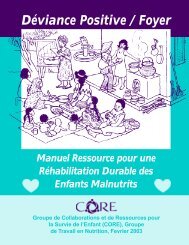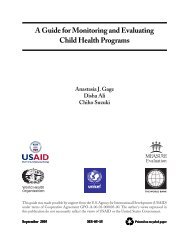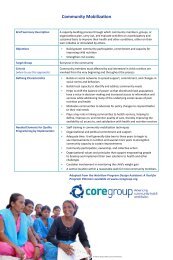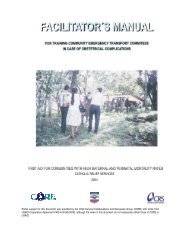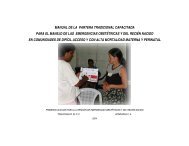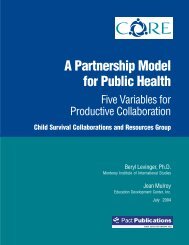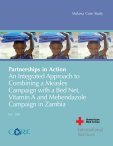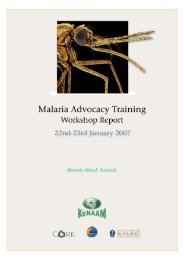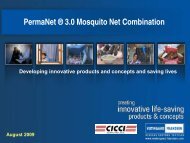Essentials of Appreciative Inquiry: A Roadmap for Creating
Essentials of Appreciative Inquiry: A Roadmap for Creating
Essentials of Appreciative Inquiry: A Roadmap for Creating
You also want an ePaper? Increase the reach of your titles
YUMPU automatically turns print PDFs into web optimized ePapers that Google loves.
The <strong>Essentials</strong> <strong>of</strong> <strong>Appreciative</strong> <strong>Inquiry</strong>:A <strong>Roadmap</strong> <strong>for</strong> <strong>Creating</strong> Positive FuturesBernard J. Mohr and Jane Magruder Watkins“The significant problems we face cannot besolved at the same level <strong>of</strong> thinking we were atwhen we created them.” —Albert EinsteinFor much <strong>of</strong> the last four centuries, humans havesought to improve the world through modern Westernscience, with its focus on linear logic and dissectingthings to understand them. When we’ve applied thisapproach to technical challenges, such as the need toshare in<strong>for</strong>mation with people on the other side <strong>of</strong> theglobe, we’ve been highly successful. Nevertheless, despitedramatic developments in technological systems, ourprogress in developing human systems, such as families,work teams, community groups, corporations, andnations has been much slower. Many people wonderwhy we can succeed so well in one sphere and have suchdifficulty in another.People interested in improving human systems <strong>of</strong>tenassume that organizational change is sequential: Wefirst ask about how an enterprise functions and thentake steps to change it based on our findings. However,a growing number <strong>of</strong> social scientists are coming torecognize that the process <strong>of</strong> studying a phenomenonactually changes that phenomenon—in effect creatinga new reality during the process <strong>of</strong> inquiry. In the early1920s, renowned physicist Werner von Heisenbergarticulated this principle <strong>for</strong> the physical world. Forexample, the act <strong>of</strong> inserting a thermometer into a glass<strong>of</strong> water to determine the water’s temperature willchange that temperature. By extension, we can inferthat studying a company or community changes thatentity. Researchers have found that this influence beginsfrom the first questions that leaders, consultants, orothers ask during the inquiry process—and that theimages evoked by their questions have an almostmagnetic pull.As a result <strong>of</strong> this new thinking, some have begun to questionthe focus <strong>of</strong> what we typically study in organizationallife. Rather than concentrate on breakdowns and malfunctions,we’ve begun to ask: If the act <strong>of</strong> studying a systemalters it, why not do so in ways that create movementtoward peak experiences or successes? Posing this query canopen our eyes to the enormous potential <strong>of</strong> the positivequestion.ContentsThe Power <strong>of</strong> the Positive Question . . . . . . . . . . . . . . . 2Origins <strong>of</strong> AI . . . . . . . . . . . . . . . . . . . . . . . . . . . . . . . . . . 2The Holistic Nature <strong>of</strong> SelfRethinking Our Approach to Organizational ChangeWhy Questions Matter: The Power <strong>of</strong> ImageAn Invitation to ChangeHow AI Works: Five Generic ProcessesGuided by Five Core Principles . . . . . . . . . . . . . . . . . 41. Choose the Positive As the Focus <strong>of</strong> <strong>Inquiry</strong>2. Inquire into Exceptionally Positive Moments3. Share the Stories and Identify Life-Giving Forces4. Create Shared Images <strong>of</strong> a Preferred Future5. Innovate and Improvise Ways to Create That FutureAI Principles in Practice:Three Stories From the Field . . . . . . . . . . . . . . . . . . . . . 9Customer Service Improvement in an HR DivisionPost-Merger Integration <strong>of</strong> Three Cultures into One at aPrimary SchoolLeadership Development Among Top Managers <strong>of</strong> anR&D DivisionHelpful Conditions <strong>for</strong> Implementingthe AI Process . . . . . . . . . . . . . . . . . . . . . . . . . . . . . . . . . . 10
The <strong>Essentials</strong> <strong>of</strong> <strong>Appreciative</strong> <strong>Inquiry</strong>: A <strong>Roadmap</strong> <strong>for</strong> <strong>Creating</strong> Positive FuturesPegasus Communications, Inc. (tel) 781-398-9700 www.pegasuscom.com3and action. Below are examples <strong>of</strong> thisresearch:The Placebo Effect: The Power <strong>of</strong>Our Own Images <strong>of</strong> Ourselves.Undertaken in the mid-1950s, theseonce controversial experiments showthat from one-third to two-thirds <strong>of</strong> allpatients will show marked physiologicaland emotional improvement in symptomssimply by believing that they arebeing given an effective treatment.Their improvements are even greater ifthe doctor prescribing the medicine ortreatment also believes it will help(Beecher, 1955; White, Turks, andSchwartz, 1985).The Pygmalion Studies: TheImpact <strong>of</strong> Another’s Image <strong>of</strong> Us.These studies <strong>of</strong> classroom behaviordemonstrate the power that anotherperson’s image <strong>of</strong> us can have in shapingour per<strong>for</strong>mance. Researchers discoveredthat teachers’ responses to individualstudents reflected what they believedabout each child’s potential and ability(Jessum, 1986; Rosenthal and Rubin,1978). Furthermore, they demonstratedthat the teacher’s image <strong>of</strong> the studentwas a more powerful predictor <strong>of</strong> his orher per<strong>for</strong>mance than IQ scores, homeenvironment, or past per<strong>for</strong>mance.Long-term follow-up showed that thisjudgment affected the students far intothe future. So damaging were theseexperiments to the children labeledpoor per<strong>for</strong>mers that the scientific communitydiscontinued them.Internal Dialogues. Evidence suggeststhat we can create positive images<strong>of</strong> ourselves through our own internalconversations. Norman Cousins popularizedthe notion that a person’s mentalstate affects his or her health. In his bookHuman Options (Berkley Books, 1981),he writes <strong>of</strong> the therapeutic value <strong>of</strong>hope, faith, love, will to live, cheerfulness,humor, creativity, playfulness, confidence,and great expectations, all <strong>of</strong>which contribute to thebody’s healing. BillMoyers created a series<strong>for</strong> PBS on the power <strong>of</strong>the mind to heal thebody. And JackNicklaus’s Golf My Way(Simon & Schuster,1974) argues that positiveinternal affirmations(“I’m going to hit itdown the middle <strong>of</strong> the fairway” ratherthan “Don’t hit it into the woods”) causethe entire body to respond to what themind imagines is possible.In the healthcare community, Jamesand Stephanie Simonton documentedan unusually high rate <strong>of</strong> recovery fromwhat was diagnosed as terminal cancerby patients who worked to resolve theirpsychological issues and practiced positiveimagery (1981). In other studies <strong>of</strong>people facing major heart surgery,behavioral scientists recorded a two-toonerecovery rate <strong>of</strong> those whoapproached the operation with confidencecompared to those whoapproached it with fear and concern(Cooperrider & Srivastva, 1990).Rethinking Our Approach toOrganizational ChangeWith such scientific evidence emerging,many <strong>of</strong> us are rethinking our approachto organizational change. For example,the Pygmalion experiments suggest thata supervisor’s focus on an employee’sshortcomings during per<strong>for</strong>manceappraisals will adversely affect thatemployee’s future per<strong>for</strong>mance. Thestudies on positive imagery imply thatemployees who hold self-images <strong>of</strong>competence and success are more likelyto achieve high levels <strong>of</strong> per<strong>for</strong>mancethan those with poorself-esteem. If weaccept that we havethe power to createwhat we imagine,then an organizationalprocess thatseeks to achieve positivechange wouldconsciously focus onempoweringemployees to believe that they can makea difference; reward leaders who knowhow to empower others; and direct theenergy <strong>of</strong> the system toward the generativeand creative <strong>for</strong>ces that give life andvitality to the work.Championed by organization development(OD) practitioners, these ideashave undergone continuous innovationand have been adopted by groups andinstitutions around the world. Somehave mistaken these new ideas <strong>for</strong>merely “positive thinking” or as justanother technique <strong>for</strong> facilitating organizationalchange. Nevertheless, manypractitioners are increasingly coming tounderstand AI to be an overall organizationalphilosophy that ultimatelytrans<strong>for</strong>ms our approach to the wholefield <strong>of</strong> OD, including knowledge management,joint ventures, post-mergerintegration, customer service, diversity,business process innovation, strategydevelopment, evaluation, capabilitydevelopment, and much more.Why Questions Matter:The Power <strong>of</strong> Image“Imagination is more importantthan knowledge.” —Albert Einstein
4The <strong>Essentials</strong> <strong>of</strong> <strong>Appreciative</strong> <strong>Inquiry</strong>: A <strong>Roadmap</strong> <strong>for</strong> <strong>Creating</strong> Positive FuturesPegasus Communications, Inc. (tel) 781-398-9700 www.pegasuscom.comAI is based on the power <strong>of</strong> positiveinquiry. But how can a simple questionnudge a whole company in a productivenew direction? Organizations are manifestations<strong>of</strong> the human imagination.That is, no organization could exist if oneor several individuals hadn’t envisioned itfirst (even if that vision was sketchy orincomplete). The learnings that surfacethrough the AI process begin to shift thecollective image that people hold <strong>of</strong> theorganization. In their daily encounters,members start to create compelling newvisions <strong>of</strong> the company’s future together,grounded in their understanding <strong>of</strong> pastsuccesses. These visions initiate “ripples”in how employees think about the workthey do, their relationships, their roles,and so on. Over time, these ripples turninto waves; the more positive questionspeople ask, the more they incorporate thelearnings they glean from those questionsinto daily behaviors and, ultimately, intothe organization’s infrastructure.To see how we might start to framesuch questions, let’s suppose a team’sper<strong>for</strong>mance has fluctuated <strong>for</strong> a whileand its members are now experiencingconflict and low productivity. Which <strong>of</strong>the following sets <strong>of</strong> questions is likelyto give us in<strong>for</strong>mation that will generate<strong>for</strong>ward momentum?What’s wrong with the people in thisgroup?Why isn’t this team doing better?What’s causing this conflict and who isresponsible?OrThink <strong>of</strong> a time in your history as a teamwhen per<strong>for</strong>mance was high and you feltengaged and valued. Tell me a storyabout that time. What were you and theothers doing?What external/organizational factorswere present that supported thesemoments?How might this team function if we couldexpand the conditions that led to pastsuccesses?Both sets <strong>of</strong> questions will generatedata that will begin to shift the team’sdynamics, but only the first will lead tothe blame, fatigue, and resistance thattypically accompany problem-focusedanalyses. Uncovering and supportingpeople’s passions, skills, knowledge,experience, and successes excite andmobilize them to implement innovationsthey never be<strong>for</strong>e thought possible.An Invitation to ChangeUnlike many behavioral approaches tochange, AI does not focus on changingpeople. Instead, it invites people toengage in building the kinds <strong>of</strong> organizationsand communities that theywant to work and live in. AI thusinvolves collaborative discovery <strong>of</strong> whatmakes an organization most effective—in economic, ecological, and humanterms. From there, people weave thatnew knowledge into the fabric <strong>of</strong> thefirm’s <strong>for</strong>mal and in<strong>for</strong>mal systems,such as the way they develop andimplement business strategy or organizethemselves to accomplish tasks.This process represents true learningand change.For instance, in Curitiba, Brazil, thefood manufacturing companyNutrimental lost a major long-timecustomer and teetered on the edge <strong>of</strong>financial disaster. In response, it shutdown <strong>for</strong> a day so that all 700 employeescould talk together about how tobeat the stiffening competition thatfaced the company. David Cooperrider(currently a faculty member at CWRU)facilitated the process. He invitedemployees to identify “the factors and<strong>for</strong>ces that gave life to the companywhen it was most effective, most alive,and most successful as a producer <strong>of</strong>high-quality health foods.”After the first day, a smaller group<strong>of</strong> 150 stakeholders—employees fromall levels, suppliers, distributors, communityleaders, financiers, and customers—begana four-day strategysession to articulate a bold, new corporatedream. Six months later, salesreached an all-time high and pr<strong>of</strong>itsrose 300 percent. Using the short-termresults as a springboard, within thenext two years, the company completedimplementation <strong>of</strong> a radical restructuring,giving employees much greaterinfluence on a day-to-day level. Thatempowerment in turn enabled thecompany to execute three new strategicinitiatives, which led to even greaterincome and pr<strong>of</strong>itability.As this example shows, the AIprocess enables human systems toengage in continuous learning andtranslate that learning into ongoinginnovation. Organizations then becomeso agile that they are capable <strong>of</strong> thrivingeven in the midst <strong>of</strong> volatility andchanging at the speed <strong>of</strong> imagination.How AI Works:Five GenericProcesses Guided byFive Core PrinciplesThe AI philosophy is captured by fivecore principles that serve as the foundation<strong>for</strong> AI’s five generic processes:
The <strong>Essentials</strong> <strong>of</strong> <strong>Appreciative</strong> <strong>Inquiry</strong>: A <strong>Roadmap</strong> <strong>for</strong> <strong>Creating</strong> Positive FuturesPegasus Communications, Inc. (tel) 781-398-9700 www.pegasuscom.com5●●●●●The Constructionist Principle: Ourorganizations evolve in the direction<strong>of</strong> the images we create based on thequestions we ask as we strive tounderstand the systems at work.The Principle <strong>of</strong> Simultaneity:Change begins the moment we askquestions.The Anticipatory Principle: Ourbehavior in the present is influencedby the future we anticipate.The Poetic Principle: Just as poetshave no constraints on what they canwrite about, we have no boundarieson what we can inquire and learnfrom.The Positive Principle: The morepositive the questions used to guide achange process, the more long-lastingand effective that process will be.Five generic processes comprise an“AI cycle,” which most people use whenintegrating AI practice into their organization(see “Five Generic Processes”).Whether you’re an external consultant,an internal organization developmentpr<strong>of</strong>essional, or a line manager, you canconsider these processes a roadmap5. Innovate andimprovise ways tocreate that futureFIVE GENERIC PROCESSES4. Create sharedimages <strong>of</strong> apreferred future1. Choose thepositive as thefocus <strong>of</strong> inquiryAITWO CONTRASTING MODELS FOR ORGANIZATIONAL CHANGE2. Inquire intoexceptionally positivemoments3. Share the storiesand identify lifegiving<strong>for</strong>cesDeficit-Based ChangeIdentify the ProblemWhat is the need?Analyze CausesWhat’s wrong here?Analyze Possible SolutionsHow can we fix it?Action PlanningProblem solved!rather than a prescription <strong>for</strong> applyingAI. You should customize them to fiteach situation, with its unique opportunitiesand constraints. Further, with onlysmall modification, you can use theseprocesses with teams, families, communities,and other groups. [Note: Literatureabout AI <strong>of</strong>ten refers to the 4D cycle:Discovery-Dream-Design-Destiny, whichalso emphasizes addressing problemsthrough inquiry into and learning fromexceptionally positivemomentsrather than analyzingbreakdowns(see “TwoContrasting Models<strong>for</strong> OrganizationalChange”). However,our experience withAI led us to rewordthe 4D cycle intothe five genericprocesses to simplifyunderstanding<strong>of</strong> how AI works.]1. Choose the Positive As theFocus <strong>of</strong> <strong>Inquiry</strong><strong>Appreciative</strong> <strong>Inquiry</strong> begins when theorganization consciously chooses t<strong>of</strong>ocus on the positive as the basis <strong>for</strong>learning and change. The first stepincludes educating key stakeholders—such as senior management, unit leaders,union leaders, and employeegroups—about the AI process, philosophy,and supporting research; providingan opportunity <strong>for</strong> them to collectivelydecide whether AI is applicable to theirorganization; and, if they choose toimplement the AI process, identifying acore team to develop a customizedinterview guide and oversee the interviewprocess. You might ask these stakeholdersquestions such as:●●Constructionist-Based ChangeDiscoveryDiscover the best <strong>of</strong> what is.DreamImagine what might be.DesignDialogue what should be.DestinyCreate what will be.Does the AI approach feel right <strong>for</strong>you and this situation?If so, what will the topic <strong>of</strong> inquirybe? How will we phrase the topicto focus on the positive as a corevalue?
7Pegasus Communications, Inc. (tel) 781-398-9700 www.pegasuscom.comThe <strong>Essentials</strong> <strong>of</strong> <strong>Appreciative</strong> <strong>Inquiry</strong>: A <strong>Roadmap</strong> <strong>for</strong> <strong>Creating</strong> Positive Futures7A group can use a generic interviewguide (see “Generic Interview Guide” onpage 6) or customize the questions t<strong>of</strong>ocus on the particular interests <strong>of</strong> itsmembers. On the right is an example <strong>of</strong>a customized interview guide. It was createdby a core team at a middle schooldealing with the fallout from a mergerthat had angered and alienated many <strong>of</strong>the staff.3. Share the Stories and IdentifyLife-Giving ForcesIn this phase, interviewers share theirfindings with the rest <strong>of</strong> the organizationso that many people can collectivelymake meaning <strong>of</strong> the data,identify learnings about the organization’spositive core and the conditionsthat support moments <strong>of</strong> high per<strong>for</strong>mance,and develop ideas <strong>for</strong> what doesnot exist that needs to be created, asdescribed in the “wish” questions. Anorganization has several options <strong>for</strong>deciding how to share the stories andin<strong>for</strong>mation and <strong>for</strong> selecting who willdo the analysis (or “sense-making”) toidentify the life-giving <strong>for</strong>ces. Sometimesa small group makes sense <strong>of</strong> thedata on behalf <strong>of</strong> the larger organization.Whenever possible, though, it is desirableto have everyone involved reviewthe interview results, <strong>for</strong> example,through an AI Summit, video conferencing,regional meetings, and so <strong>for</strong>th.A major part <strong>of</strong> the sense-makingwork is to identify themes, or importantthreads, gleaned from the interviews.Themes are the short answers tothe question: “What do we hear peopledescribing in the interviews as the lifegiving<strong>for</strong>ces in this organization?”They become the basis <strong>for</strong> collectivelyimagining what the organization wouldSAMPLE CUSTOMIZED INTERVIEW GUIDE FOR A SCHOOL MERGER1. In each <strong>of</strong> our lives, there are special times when we just know that we havemade the right career choice—moments when we feel really good about thework we are doing and what we are contributing to others. As you think backover your last four or five years at this or another school, can you tell me a storyabout one <strong>of</strong> those special moments when you felt that your teaching was reallyalive and meaningful <strong>for</strong> your students—a time when you felt particularlyexcited about your involvement in your field, when you were affirmed in yourcommitment to being part <strong>of</strong> the teaching/learning field? (Use the questionsbelow to probe more deeply, to help your interviewee expand his or her story.)● What made it a peak experience? What was happening at that time inyour life?● What were the students doing?● How were you interacting with them?● What was it about the learning climate and task that sparked theirengagement?2. Without being humble, tell me what you value deeply about yourself as anindividual? as an educator?3. In planning this process, the sponsor team has said that one <strong>of</strong> the thingsthat enable great teaching/learning is when people in the school “feel connected,”when they feel “part <strong>of</strong> a family.” Thinking back over the last few years, can youtell me a story about a time when you felt that sense <strong>of</strong> connectedness, that sense<strong>of</strong> family? (Use the questions below to probe more deeply, to help your intervieweeexpand his or her story.)● What role did you play?● What did others contribute?● What other factors in the situation, in the environment, contributed tothis connectedness?4. With the hectic pace <strong>of</strong> today’s world and the need to juggle lots <strong>of</strong> differentballs at once, feeling valued and supported by the people around you can make abig difference. Would you tell me a story about a specific time, an experiencewhen, as a pr<strong>of</strong>essional, you felt genuinely supported and/or valued by students?by your peers? by the administration?5. In your view, what are the community and societal expectations <strong>of</strong> this school<strong>for</strong> the future?6. What is the core factor that gives vitality and life to the school—the one thingthat is important <strong>for</strong> us to retain, to bring with us as we move into the future?7. What three wishes do you have <strong>for</strong> this school—things that would enable it tobecome even more vibrant and truly the sort <strong>of</strong> place in which great learningand teaching take place on a daily basis?
8The <strong>Essentials</strong> <strong>of</strong> <strong>Appreciative</strong> <strong>Inquiry</strong>: A <strong>Roadmap</strong> <strong>for</strong> <strong>Creating</strong> Positive FuturesPegasus Communications, Inc. (tel) 781-398-9700 www.pegasuscom.combe like if the exceptional moments thatwe have uncovered in the interviewsbecame the norm. Themes also providethe link from this step in the process tothe next one, in which the group createsa shared image <strong>of</strong> their preferred future.To see how the first three phases interacttogether to assist the group in articulatingtheir preferred future, see“Making Sense <strong>of</strong> the AI Interviews.”4. Create Shared Images <strong>of</strong> aPreferred FutureIn the fourth process <strong>of</strong> the AI cycle,participants articulate a shared imageor dream <strong>of</strong> the most desired future <strong>for</strong>the entire organization. Doing soinvolves inviting organization stakeholdersto engage in “possibility conversations”about the organization’sposition, its potential, its calling, andthe unique contribution it can make toglobal well-being.The first part <strong>of</strong> this process usuallyfocuses on descriptions <strong>of</strong> the organization’sculture, the ways in which peoplerelate to one another, and the overallfeel <strong>of</strong> the organization. The followingquestions can be useful <strong>for</strong> initiatingdialogue:● What is the world calling <strong>for</strong> ourorganization to be?● What are the most enlivening andexciting possibilities <strong>for</strong> ourorganization?● What is the inspiration that supportsour organization?These paths <strong>of</strong> inquiry generate anoverall “macro” vision <strong>for</strong> how the groupwants the organization to function—ashort narrative description <strong>of</strong> the desiredfuture written in the present tense.MAKING SENSE OF THE AI INTERVIEWSIn the middle school previously described, interviewees identified the followingthemes—that is, conditions that were present in the past that led to moments <strong>of</strong>excellence in teaching, learning, and quality <strong>of</strong> work life.● Authentic learning experiences● Collaborative ef<strong>for</strong>ts between teachers, students, and parents, and betweenteachers and administrators● High standards <strong>of</strong> classroom dialogue● Positive climate, including ongoing support and effective communicationamong staff, colleagues, students, and administration● Sense <strong>of</strong> community and connectedness at different levels, with feelings <strong>of</strong>appreciation and kindness● Time to connect with kids and colleagues at different levels● Purposeful planning and work● Parent involvement● High teacher energyParticipants in the AI process presentthis vision—or “provocative proposition”—tothe larger organization firstcreatively and metaphorically (throughsongs, skits, collages, and so <strong>for</strong>th) andthen in writing. For example, at a consumerproducts firm, participants cameup with the following macro vision:“Our company is a learning organizationthat fosters the cross-fertilization <strong>of</strong>ideas, minimizes the building <strong>of</strong>empires, harnesses the synergy <strong>of</strong> groupcooperation, and cultivates the pride <strong>of</strong>being a valued member <strong>of</strong> one outstandingcorporation.”The second part <strong>of</strong> this processinvolves the participants in producing amore specific, detailed vision <strong>for</strong> howthe organization might function. This“micro” vision describes the structures,mechanisms, technologies, processes,and strategies that will help make thedesired future a reality. Ideally, thisactivity engages as many people as possibleand emerges directly from theinterviews and resultant themes. Theconsumer products firm mentionedabove identified 20 elements that theyfelt could be infused with the power <strong>of</strong>their vision <strong>for</strong> a new corporate culture.Their micro vision <strong>for</strong> the strategydevelopment process was: “Our companyaccelerates its learning through anannual strategic planning conferencethat involves all 500 people in the firmas well as key partners and stakeholders.As a setting <strong>for</strong> strategic learning, teamspresent their benchmarking studies <strong>of</strong>the best five other organizations,deemed leaders in their class. Otherteams present an annual appreciativeanalysis <strong>of</strong> our company, and togetherthese databases <strong>of</strong> success stories (internaland external) help set the stage <strong>for</strong>our strategic, future-search planning.”
The <strong>Essentials</strong> <strong>of</strong> <strong>Appreciative</strong> <strong>Inquiry</strong>: A <strong>Roadmap</strong> <strong>for</strong> <strong>Creating</strong> Positive FuturesPegasus Communications, Inc. (tel) 781-398-9700 www.pegasuscom.com95. Innovate and Improvise Ways toCreate That FutureThe final process seeks to engage asmany members <strong>of</strong> the organization aspossible in bringing to life, on a dailybasis in every locale, the new images <strong>of</strong>the future articulated in the previoussteps. At this stage, the momentum andpotential <strong>for</strong> innovation are extremelyhigh. Some people in the organizationmight <strong>for</strong>m “initiative” groups aroundimplementing the micro visions, supportedby ongoing inquiry into how thenew changes are working.In another variation, each personhas the opportunity to publicly state asimple commitment, make an <strong>of</strong>fer,orarticulate a request about which parts <strong>of</strong>the dream he or she wants to bring tolife. A simple commitment describesactions that can be taken easily, typicallywithin one to two weeks andwithin the existing authority andresources available to the person makingthe commitment. An <strong>of</strong>fer is a kind<strong>of</strong> “gift” that can come in any <strong>for</strong>m. Forexample, a participant may <strong>of</strong>fer accessto a database she controls; someone elsemay <strong>of</strong>fer financial assistance to get aproject started; another person may<strong>of</strong>fer his help in response to a request<strong>for</strong> collaboration. A request articulateswhat one person or group needs fromanother person or group; <strong>for</strong> example,“The western region call center requestsa meeting with the chief in<strong>for</strong>mation<strong>of</strong>ficer to explore upgrading our e-mailsystem.”The key to sustaining this momentumis to build an “appreciative eye” intoall the organization’s systems, procedures,and ways <strong>of</strong> working. Best practices<strong>for</strong> doing this include continuinginquiry into key business issues, updatingthe micro and macro visions, andconducting appreciatively based evaluations<strong>of</strong> progress toward the vision—especially with new members <strong>of</strong> theorganization. Organization members arethereby involved in continuous learning,adjustment, and improvisation as theyexperiment with different ways <strong>of</strong> carryingthe vision <strong>for</strong>ward.AI Principles inPractice: ThreeStories From the FieldCustomer Service Improvement inan HR DivisionIn this company, two groups within thehuman resources function, separated bycultural and organizational boundaries,did not communicate effectively, resultingin frustrated clients who receivedconflicting advice. Over a period <strong>of</strong>weeks, through multiple dialoguesbetween consultants and key stakeholders,the departments reframed theirissue “internal conflict and lack<strong>of</strong> cooperation” from theinquiry “ServiceWithout Boundaries.”They <strong>for</strong>med a coregroup with representativesfrom all the stakeholdergroups and trainedthem in AI. This core group thendeveloped an interview guide andplanned a three-day, 300-person meetingcalled an “AI Summit.” The executivevice president served as the projectsponsor.At the AI Summit, participantsinterviewed each other in pairs usingthe customized interview guide. Groups<strong>of</strong> six then analyzed the stories and collatedthemes/life-giving <strong>for</strong>ces <strong>for</strong> inno-vations in customer service workprocesses, roles, and relationships.Report-outs took the <strong>for</strong>m <strong>of</strong> an “artgallery walk”—a tour <strong>of</strong> each group’sflip charts displayed around the room.Next, groups <strong>of</strong> 12 created pictures,skits, and songs <strong>of</strong> the ideal future organizationalculture and systems, whichthey presented to the other groups.Participants then organized themselvesinto self-selected task groups to createvisions <strong>for</strong> key organizational elements,such as leadership, work processes,reward systems, in<strong>for</strong>mation systems,and so on.Over the next year, Summit participantsreturned to their regional <strong>of</strong>ficesthroughout the country to engage colleaguesin implementing changes at thelocal level. One year later, an appreciativelybased evaluation process was usedto measure progress. The 600-memberHR division and some <strong>of</strong> its clients identifiedapproximately 300 stories <strong>of</strong>improvements and innovations. Thisdata <strong>for</strong>med the basis <strong>for</strong> yetanother three-daySummit, atwhich thefollowingquestionswere discussed:What have weaccomplished? What’sworking well in our change process?Where do we want to move to now?How do we build on the best <strong>of</strong> our successto get there?Additional staff members have beentrained in AI, particularly those in theorganization development function,which has grown tremendously in personneland financial resources to supportongoing AI practice. Rather thanRather than considering thechange process a one-time event,the organization now sees it as thenormal way <strong>of</strong> doing things.
The <strong>Essentials</strong> <strong>of</strong> <strong>Appreciative</strong> <strong>Inquiry</strong>: A <strong>Roadmap</strong> <strong>for</strong> <strong>Creating</strong> Positive FuturesPegasus Communications, Inc. (tel) 781-398-9700 www.pegasuscom.com11action, as people became inspired byhow their colleagues were moving <strong>for</strong>ward.The organization has since createdan internal positive change network <strong>of</strong>people trained in AI basics, and the divisionis applying AI to per<strong>for</strong>mance management,innovation, safety, <strong>of</strong>ficedesign, knowledge transfer, strategyimplementation, and other areas.Helpful Conditions<strong>for</strong> Implementingthe AI ProcessThough not an absolute prerequisite,we have found the following conditionsto be helpful in implementing AI toachieve rapid organizational learningand change:● Humble beginnings: The organizationhonestly acknowledges any currentdifficulties without assigningblame and invites co-construction <strong>of</strong>solutions that do not yet exist.● Congruence <strong>of</strong> means and ends: Theinquiry process itself and the endresults are congruent. For example,an organization seeking to increasethe meaningful involvement <strong>of</strong>minority groups in all aspects <strong>of</strong>●●●organizational life must have significantparticipation from those groupsin planning the inquiry, creating thecustomized interview guide, anddeveloping the innovations that willbe required.History as a source <strong>of</strong> innovation:Key leaders believe that the organization’shistory is a source <strong>of</strong> newpossibilities and are intrigued withthe notion that accessing its “positivecore” can drive learning and change.They support participation <strong>of</strong> allvoices at all levels and are open tothe resultant innovation ideas.Focus beyond the event: Members <strong>of</strong>the organization see AI as a process<strong>for</strong> creating a culture open to learning,discovering new possibilities <strong>for</strong>organizing, and producing results inways that raise the collective standard<strong>of</strong> living in the organization and thecommunity, as well as on the planet.Learning and change are seen asongoing processes rather than a onetimeevent that brings the organizationto some final point <strong>of</strong> excellence.Stories more than numbers: Theorganization supplies the structuresand resources needed to collect anddistribute stories <strong>of</strong> “exceptionalmoments” and support creativeaction. Stories become valued <strong>for</strong>their ability to capture the wholeness<strong>of</strong> meaning.<strong>Appreciative</strong> <strong>Inquiry</strong> is a highlyadaptable philosophy and process <strong>for</strong>engaging people in building the organizationsand world that they want towork and live in. AI assumes that everyliving system has untapped stories <strong>of</strong>excellence and that these stories, whensystematically explored and shared,release positive energy. The AI processinvites people to consciously choose toseek out and inquire into these <strong>for</strong>cesin their own and other people’s livesand to explore their hopes and dreams<strong>for</strong> the future. It then enables people toweave their discoveries into the fabric<strong>of</strong> the organization’s <strong>for</strong>mal and in<strong>for</strong>malinfrastructure, enabling the systemto reconceptualize and trans<strong>for</strong>m itspurpose, processes, and design in waysthat support its most generative <strong>for</strong>cesand ongoing success.
12The <strong>Essentials</strong> <strong>of</strong> <strong>Appreciative</strong> <strong>Inquiry</strong>: A <strong>Roadmap</strong> <strong>for</strong> <strong>Creating</strong> Positive FuturesPegasus Communications, Inc. (tel) 781-398-9700 www.pegasuscom.comSuggested Further ReadingsAnderson, Harlene, et al, The<strong>Appreciative</strong> Organization (TaosInstitute Publishing, 2001)Cooperrider, David, et al., <strong>Appreciative</strong><strong>Inquiry</strong>: An Emerging Direction <strong>for</strong>Organization Development (StipesPublishing, 2001)Cooperrider, David, and DianaWhitney, <strong>Appreciative</strong> <strong>Inquiry</strong>:Collaborating <strong>for</strong> Change (Berrett-Koehler, 1999)Fry, Ronald, et al., <strong>Appreciative</strong> <strong>Inquiry</strong>and Organizational Trans<strong>for</strong>mation:Reports from the Field (Quorum Books,2002)Magruder Watkins, Jane, and Bernard J.Mohr, <strong>Appreciative</strong> <strong>Inquiry</strong>: Change atthe Speed <strong>of</strong> Imagination (JosseyBass/Pfeiffer, 2001)Schiller, Marjorie, et al., <strong>Appreciative</strong>Leaders: The Eye <strong>of</strong> the Beholder (TaosInstitute, 2001)Bernard J. Mohr, president <strong>of</strong> The Synapse Group, Inc., and a founding partner <strong>of</strong><strong>Appreciative</strong> <strong>Inquiry</strong> Consulting, LLC, is a leading practitioner and innovator in<strong>Appreciative</strong> <strong>Inquiry</strong>. For 35 years, he has helped clients with organization renewaland trans<strong>for</strong>mation, transcultural partnerships, organization (re)design, changeleadership, and the creation <strong>of</strong> cultures supporting organizational learning. He coauthored<strong>Appreciative</strong> <strong>Inquiry</strong>: Change at the Speed <strong>of</strong> Imagination (Jossey Bass, 2001).Bernard holds an M.Ed. in adult and organizational learning from OISE at theUniversity <strong>of</strong> Toronto and a diploma in organizational design from ColumbiaUniversity.Jane Magruder Watkins, a past chair <strong>of</strong> the board <strong>of</strong> the NTL Institute <strong>for</strong> AppliedBehavioral Science, has worked in the field <strong>of</strong> organization development <strong>for</strong> 35 years.Since the mid-1980s, she has pioneered the use <strong>of</strong> <strong>Appreciative</strong> <strong>Inquiry</strong> in corporate,nonpr<strong>of</strong>it, and government organizations across the globe. She teaches AI throughthe Taos Institute, NTL Institute, in client organizations, and <strong>for</strong> several universitygraduate programs. Jane coauthored <strong>Appreciative</strong> <strong>Inquiry</strong>: Change at the Speed <strong>of</strong>Imagination with Bernard Mohr. She holds an M.S. in organizational development.We are grateful <strong>for</strong> the dialogues and support <strong>of</strong> our many colleagues in <strong>Appreciative</strong><strong>Inquiry</strong> Consulting and would like to particularly acknowledge the published works<strong>of</strong> David Cooperrider, Frank Barrett, Jim Ludema, Marjorie Schiller, and DianaWhitney.



